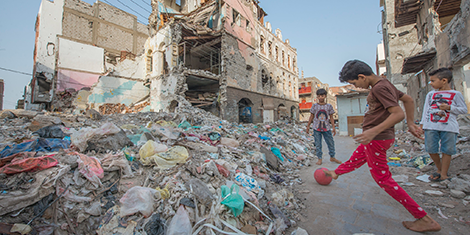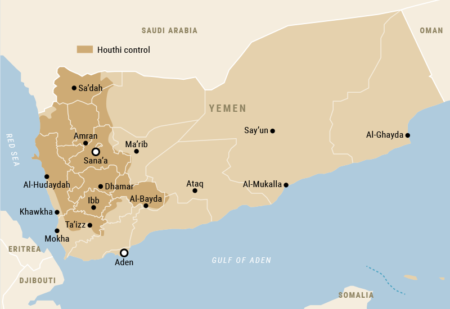
This article was originally published by the Danish Institute for International Studies (DIIS) in August 2019.
The conflict in Yemen will not be solved by a peace agreement between the Houthis and the internationally recognized government due to the increased fragmentation of internal political and economic structures.
The United Nations (UN) describes the conflict in Yemen as the world’s largest humanitarian disaster, as more than an estimated 24 million Yemenis currently need assistance. This underscores the urgent need for a comprehensive peace agreement. However, whereas the UN-led ongoing peace negotiations focuses on the elite level, sustainable peace in Yemen will depend on whether or not local actors are incorporated into the transitional political process and the future Yemeni state.
Recommendations
- Denmark is well positioned to take on a bigger role in pushing for a sustainable peace agreement and a realistic transitional framework.
- Denmark should prioritize building close links with local actors.
- Denmark should support and empower local authorities and communities in parallel with an effort to build the capacity of the Yemeni state.
The UN has found it difficult to convince the Houthis and the internationally recognized government to engage in negotiations, let alone commit to a comprehensive peace agreement. One substantial hurdle is that both the Houthis and the government of President Abd Rabbuh Mansour Hadi will most likely lose influence as a consequence of a peace agreement. At the same time, the involvement of regional actors in the conflict, such as Saudi Arabia (KSA) and the United Arab Emirates (UAE), complicates negotiations. Nevertheless, the EU, including Denmark, should push for a comprehensive peace agreement and an end to the Saudi-led military campaign. However, this is only one element in bringing a sustainable peace to Yemen. A second point of focus should be support to long-term political and economic development, including local development due to the Yemen’s fragmented political reality.
Political fragmentation
The ongoing UN-led negotiations focuses on elite-level politics. President Hadi, a transitional president, continues to represent institutional legitimacy to the UN as formulated in UN Resolution 2216, adopted in 2015. However, he has limited support in Yemen, including in the south, which is supposedly under government control. Even in Aden, the seat of Hadi’s government, there is a strong but diverse separatist movement. One of the strongest actors is the Southern Transitional Council (STC), backed by the UAE. The STC has directly challenged Hadi’s authority as President, which has occasionally escalated into armed clashes. The situation further escalated in August 2019 where STC aligned forces demonstrated their strength on the ground by taking over Aden.
In the north, the Houthis have imposed a hierarchical system of control that is gradually taking over the remnants of the Yemeni state. Their mode of governance is coercive, which, in combination with their ability to resist the Saudi-led military intervention, has helped the Houthis sustain internal cohesion. However, there are substantial political differences within those who are formally aligned with the Houthis, and the Houthis themselves are not a uniform group. It is likely that, in the absence of a shared external enemy, the north of Yemen would see an increase in internal conflicts.

Economic collapse
The ongoing military intervention that began in March 2015, along with the blockade of the country’s airspace and key seaports in Al-Hudaydah, has undermined the Yemeni economy. This has in part been a deliberate strategy by the conflicting parties, who have used the economy to gain leverage over their opponents. The war economy has created dynamics that helps perpetuate the conflict, as many of the actors involved in it are reaping economic benefits. The internationally recognized government could do more to facilitate economic development initially benefiting the south, such as easing access for imports through de-bureaucratizing.
In 2016, the Central Bank of Yemen (CBY), based in the capital Sana’a, had to suspend public-sector salaries, which until then had been paid nationwide, due to a lack of funds. This was followed by a political decision on the part of President Hadi to move the CBY from Sana’a to Aden. However, in Aden the Bank has struggled to become fully functional, while many public servants under Houthi control have not received salary on a regular basis since August 2016.
Simultaneously, the exchange rate for the Yemeni rial has more than doubled compared to the pre-conflict rate. Thus, the growing number of starving Yemenis is not so much the result of food scarcities but rather of a lack of incomes, rising prices and the depreciation of the rial, which have left an increasing number of Yemenis unable to buy basic commodities, fuel and medicine.The Yemeni economy was dependent on the export of natural resources before the conflict, and while this remains the case, revenues have dwindled during the crisis. However, some areas, most notably Ma’rib, east of Sana’a, whose exports of natural resources accounted for 40% of total production in 1990-2012 according to the World Bank, has used the power vacuum to take control of local deposits of natural resources.
Ma’rib has grown from a population of 400,000 before the conflict to around 1.5 million now and has seen relative stability since 2015, despite its proximity to active frontlines. This has resulted in an economic boom and improvements to service delivery. Ma’rib is an example of the potential of local development,but at the same time it is also the result of a unique coalescence of factors that cannot be directly replicated elsewhere in Yemen.
Locally led development can help stabilize Yemen
Yemen has a long tradition of local development, and extended family networks continue to show remarkable innovation in stretching limited resources. However, whereas the political and economic fragmentation underscores the need for locally relevant approaches, local sources of authority should not be seen as a panacea for all Yemen’s problems. While some local authorities work to mitigate the consequences of the conflict, others are benefitting from its continuation through smuggling, skimming off aid, or taking advantage of the collapse of the central state to keep taxes or incomes from natural resources.
The political and economic fragmentation means that local actors are increasingly focused on their own areas, whereas the Yemeni central state, which has never had much of a presence outside the larger cities, is seen as obsolete at best and an obstacle at worst.The Yemenis must decide whether there is a future for a united Yemen, but regardless of the overall political structure, locally led decentralization can help stabilize Yemen.
What can be done?
Yemen is strategically placed on the Arabian Peninsula, where it controls the Bab al-Mandeb strait. The strait is located between Yemen, Djibouti and Eritrea and is an access point to the Suez Canal. However, it is its relationship to Saudi Arabia that has mostly defined recent Yemeni politics. Denmark can push to increase international pressure on the warring parties, including Saudi Arabia and the United Arab Emirates, as well as work to strengthen a united and ambitious EU policy towards Yemen. Yemen’s neighbors will most likely remain the dominant forces in Yemen, but Denmark and our partners can affect positive change in the country.
First, in order to work effectively in Yemen, with its high degree of political and economic fluidity, it is crucial to prioritize the building of close links with local actors. Working in Yemen requires a willingness to accept mistakes, but these can be minimized by basing decisions on how and who to work with on information from local sources and a process of triangulation.
Second, the limited capacity of formal state structures should not lead to the establishment of parallel donor-funded structures. Whereas these might increase donor’s effectiveness and ability to monitor activities in the short term, resources should be allocated to building sustainable structures both nationally and locally. The EU and Denmark must be pragmatic and work where it is possible to do so, as in Ma’rib, but should recognize that support to only some local communities risks exacerbating existing cleavages and divisions.
Finally, an end to the Saudi-led military intervention is a precondition for peace, but it will not in itself bring peace to Yemen. The international community needs to commit itself to long-term engagement in Yemen if the cycle of continued internal violence is to be broken, as the current conflict has exacerbated political, cultural and economic cleavages.
About the Author
Maria-Louise Clausen is a researcher at the Danish Institute for International Studies (DIIS).
For more information on issues and events that shape our world, please visit the CSS website.

